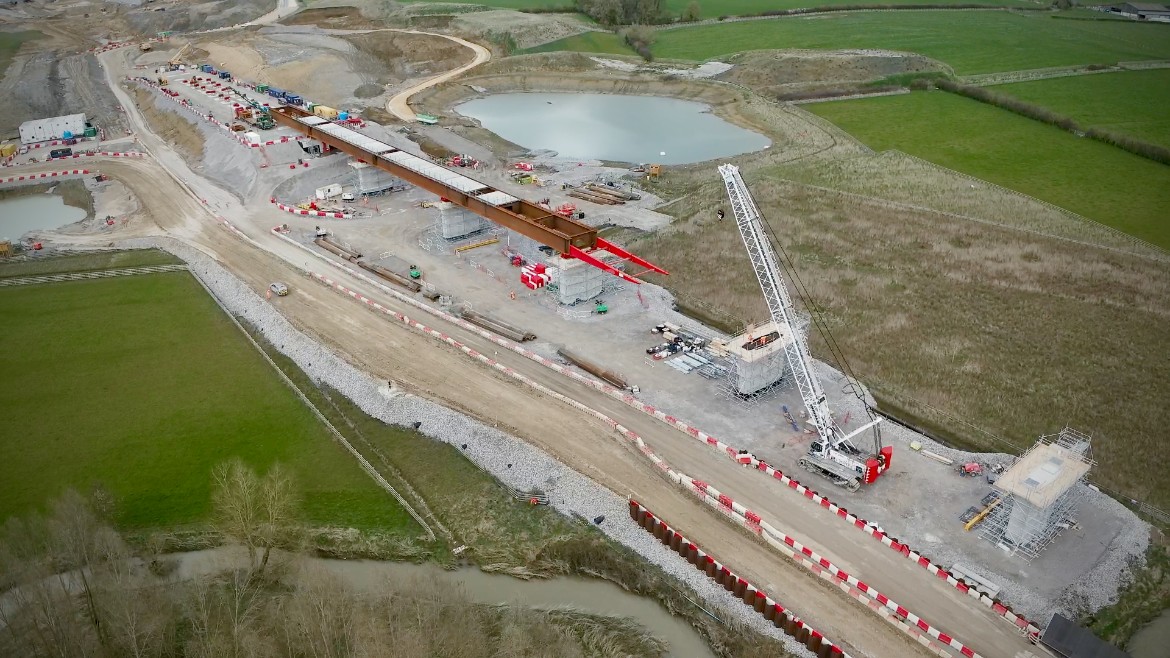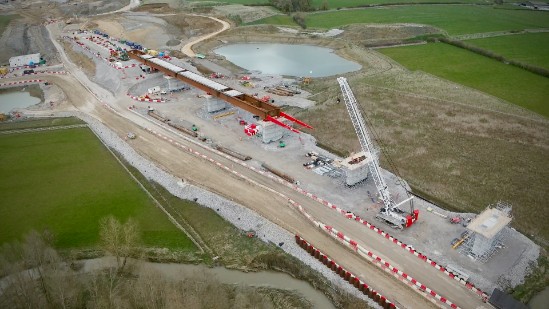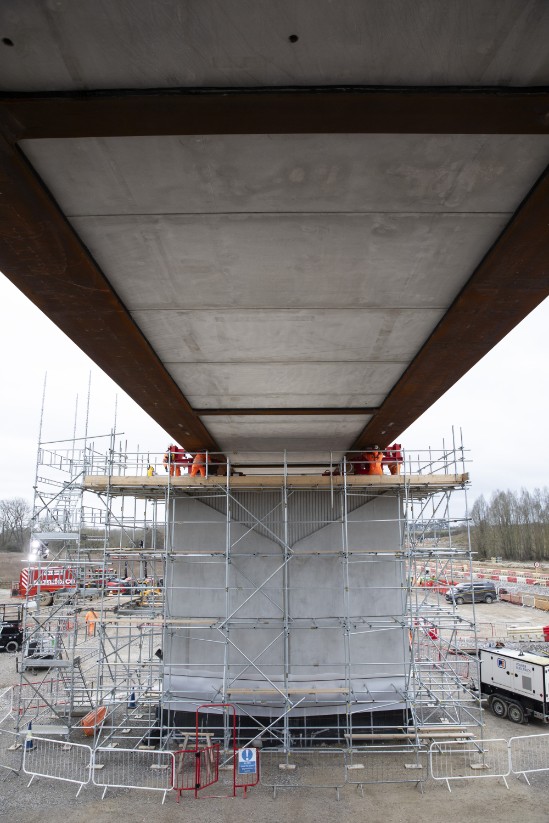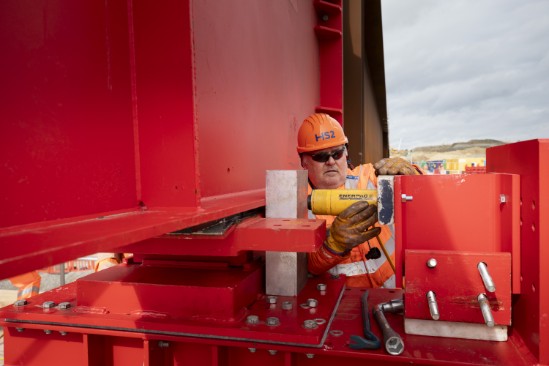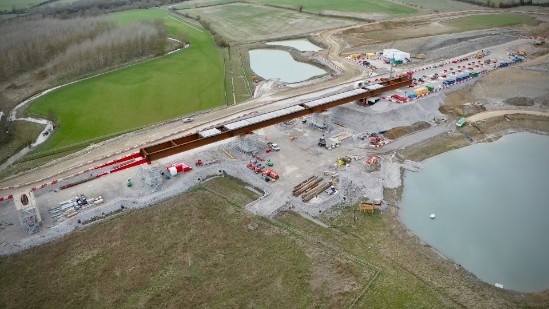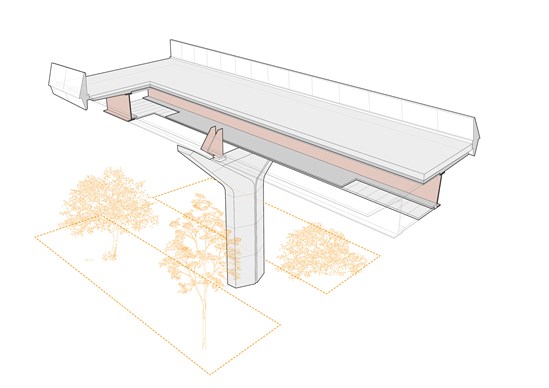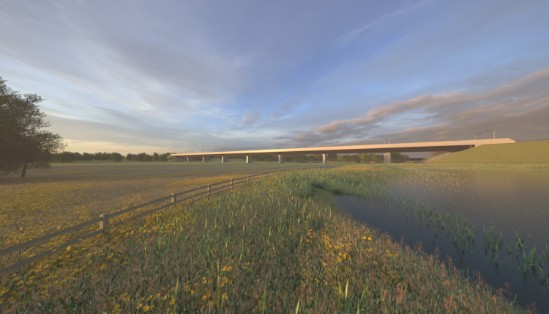HS2 today revealed that designers and engineers working on five key viaducts have succeeded in cutting their carbon footprint by up to two thirds (66%) by adopting an innovative ‘double composite’ structure which uses significantly less concrete and steel than a more traditional design.
The news comes as HS2 engineers at Westbury on the Buckinghamshire/Oxfordshire border began carefully sliding the second of the new viaduct decks into position.
The team rolled out the more efficient design to four viaducts in Buckinghamshire, Oxfordshire and West Northants following the early success of HS2’s first double composite viaduct at nearby Wendover Dean. The approach built on lessons learnt from European high speed rail projects.
Single composite structures, where steel beams support a reinforced concrete deck between the viaduct piers, are common across the UK. But by adding a concrete bottom to form a hollow box-like structure, the double composite approach becomes far more efficient, allowing the overall thickness of the concrete and steel to be reduced.
The production of these two materials is one of the major drivers of carbon emissions for the construction industry. This move helped the design team cut the amount of embedded carbon in the five viaducts – at Westbury, Turweston, Wendover, Small Dean and Lower Thorpe - by between 52 and 66 per cent.
All the viaducts were designed by HS2’s main works contractor EKFB, a team made up of Eiffage, Kier, Ferrovial Construction and BAM Nuttall – working with ASC (a joint venture between Arcadis, Setec and COWI) and architects Moxon.
HS2 Ltd’s Head of Civil Structures, Tomas Garcia, said:
“HS2 will improve journeys between Britain’s two biggest cities while freeing up more space on the most overcrowded parts of the existing mainline for more local services. Construction is well underway, and it’s great to see the lessons learnt from Wendover Dean, rolled out to four other major structures.
“The double composite approach – which combines the strength of steel in tension and with concrete in compression – has huge potential to cut carbon in construction by enabling more efficient bridges. I look forward to seeing them completed and hope the lessons we have learnt can be successfully applied to other bridge projects across the UK.”
One of the five viaducts is near Brackley, where work has just begun to slide the 320-metre-long double composite deck into position. Designed to carry the railway over the floodplain of the River Great Ouse, the Westbury viaduct will be supported by seven evenly spaced piers, each up to 9.2m tall.
It is one of 50 major viaducts on the HS2 project – which will improve connections between London, Birmingham and the North while freeing up space for more local trains on the most congested southern end of the existing West Coast Main Line into London Euston.
The viaduct deck was originally planned to be made from solid concrete beams, but after the early success of Wendover Dean the decision was taken to adopt the double composite approach across more viaducts, including Westbury.
The more efficient deck also allows longer spans and fewer piers needed to support the structure. These changes, alongside the use of lower-carbon concrete and steel, and changes to the foundations allowed the design team to cut the amount of embedded carbon in Westbury viaduct by 60% per cent.
Jose Candel, EKFB’s Design Delivery Director commented:
“The double composite design of this group of viaducts spanning Bucks and Northants, is exemplary here in the UK. The innovative deck consists of steel and concrete elements acting together to form a high-structural capacity, but lightweight hollow cross-section and we're pleased to be able to apply this design concept to five structures across HS2’s central section.
“Its implementation has been possible thanks to multidisciplinary collaboration and partnership with the supply change such as Eiffage Metal, to achieve a design which fully integrates their know-how and the considerations of the construction process, which enables a high degree of off-site manufacturing.
“This industry-leading approach is innovating and paving the way for future infrastructure projects which will not only benefit on-site construction but supports EKFBs drive to reduce a huge amount of carbon in the process.”
All of the viaducts will have their decks slid into position. Because of the length of the Westbury viaduct, the deck is being assembled in three stages, with each one pushed out from the north abutment before the next section is attached behind it.
This painstaking 11-hour process means that the weight of the deck will increase with each push, up from an initial 1,145 tonnes this week to 2,695 tonnes by the end of the year.
A winch is used to push the deck forward at a speed of around 9 metres per hour, sliding across Teflon pads to reduce friction – a material usually found to the surface of a non-stick frying pan.
Gerard Brennan, ASC Viaducts Lead Engineer and Technical Director, COWI in the UK, said:
“The ASC team is proud to have contributed to the design of these innovative structures, which have been optimised for minimum material use and maximum embedded carbon reduction. The design of these launched viaducts has been developed in close co-operation with EKFB and Eiffage Metal for maximum construction efficiency and a safer method of working over floodplains and other obstacles.”
The last few months has also seen significant progress at HS2’s other major viaducts, with the first deck slide for the enormous Delta Junction over the A42/M6 link road outside Birmingham and the start of a half-kilometre deck slide at Wendover Dean.
In total, HS2 is building more than 500 bridging structures – ranging from small road bridges to massive viaducts like the record-breaking Colne Valley Viaduct which is set to become the longest in the UK.
